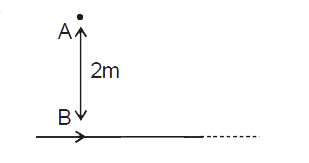Two radio transmitters radiating in phase are located at point A and B, 250 m apart. The ratio wave have frequency of 3MHz. A radio receiver is moved out from point B along a line BC (perpendicular to AB). The distance from B beyond which the detector does not detect any minima si :

200 m
400 m
600 m
500 m
The correct Answer is:C
Topper's Solved these Questions
- WAVE OPTICSBOOK - DC PANDEYCHAPTER - WAVE OPTICSEXERCISE - For JEE Advanced B. More than one option is correct
5 Videos
- WAVE OPTICSBOOK - DC PANDEYCHAPTER - WAVE OPTICSEXERCISE - For JEE Advanced C. Comprehension Type Questions. Passage (I)
2 Videos
- WAVE OPTICSBOOK - DC PANDEYCHAPTER - WAVE OPTICSEXERCISE - For JEE main (Only one option is Correct )
22 Videos
- SOLVED PAPERS 2018BOOK - DC PANDEYCHAPTER - SOLVED PAPERS 2018EXERCISE - JIPMER
22 Videos
Similar Questions
Two radius antennas radiating wave in phase are located at point A and B ,200m part(figure) The radio waves have a frequency of 6MHz.A radio receiver in moved out form pointB along a line perpendicular to the line connecting A and B(lineBC shown in figure)at time distances from B will there be destructive interference?

View SolutionTwo identical loudspeakers are located at point A & B,2m apart. The loudspeakers are driven by the same amplifier (coherent and are in phase). A small detector is moved out from point B along a line frequency below which there will be no position

View Solution
Knowledge Check
A balloon moving in a straight line passes vertically above two points A and B on a horizontal plane 300 ft apart. When above A it has an altitude of 30∘ as seen from A. The distance of B it has an altitude of 30∘ as seen from A. The distance of B from the point C where it will touch the plane is
A150(√3+1)ftB150ftC150(3+√3)ftD300(√3+1)ft
Two identical loudspeakers are located at point A & B,2m apart. The loudspeakers are driven by the same amplifier (coherent and are in phase). A small detector is moved out from point B along a line frequency below which there will be no position

View SolutionTwo identical loudspeakers are located at points A & B, 2 m apart. The loudspecakers are driven by the same amplifier. A small detector is moved out from B along a line perpendicular to the line connecting A & B. Taking speed of sound in air as 332m/s. Find the frequency below which there will be no position along the line BC at which destructive interference occurs.

View SolutionTwo fixed, equal, positive charges, each of magnitude 5×10−5 coul are located at points A and B separated by a distance of 6m. An equal and opposite charge moves towards them along the line COD, the perpendicular bisector of the line AB.
The moving charge, when it reaches the point C at a distance of 4m from O, has a kinetic energy of 4 joules. Calculate the distance of the farthest point D which the negative charge will reach before returning towards C.

View SolutionTwo fixed, equal, positive charges, each of magnitude 5×10−5 coul are located at points A and B separated by a distance of 6m. An equal and opposite charge moves towards them along the line COD, the perpendicular bisector of the line AB.
The moving charge, when it reaches the point C at a distance of 4m from O, has a kinetic energy of 4 joules. Calculate the distance of the farthest point D which the negative charge will reach before returning towards C.

View SolutionTwo points A and B have coordinates (1,1) and (3,−2) respectively. The co-ordinates of a point distant √85 from B on the line through B perpendicular to AB are
View SolutionA balloon moving in a straight line passes vertically above two points A and B on a horizontal plane 300 ft apart. When above A it has an altitude of 30∘ as seen from A. The distance of B it has an altitude of 30∘ as seen from A. The distance of B from the point C where it will touch the plane is
View SolutionA balloon moving in a straight line passes vertically above two points A and B on a horizontal plane 1000 ft. apart, when above A it has an altitude of 60∘ as seen from B when above B it has an altitude of 45∘ as seen from A. the distance of A from the point at which it will touch the plane is _____
View Solution
